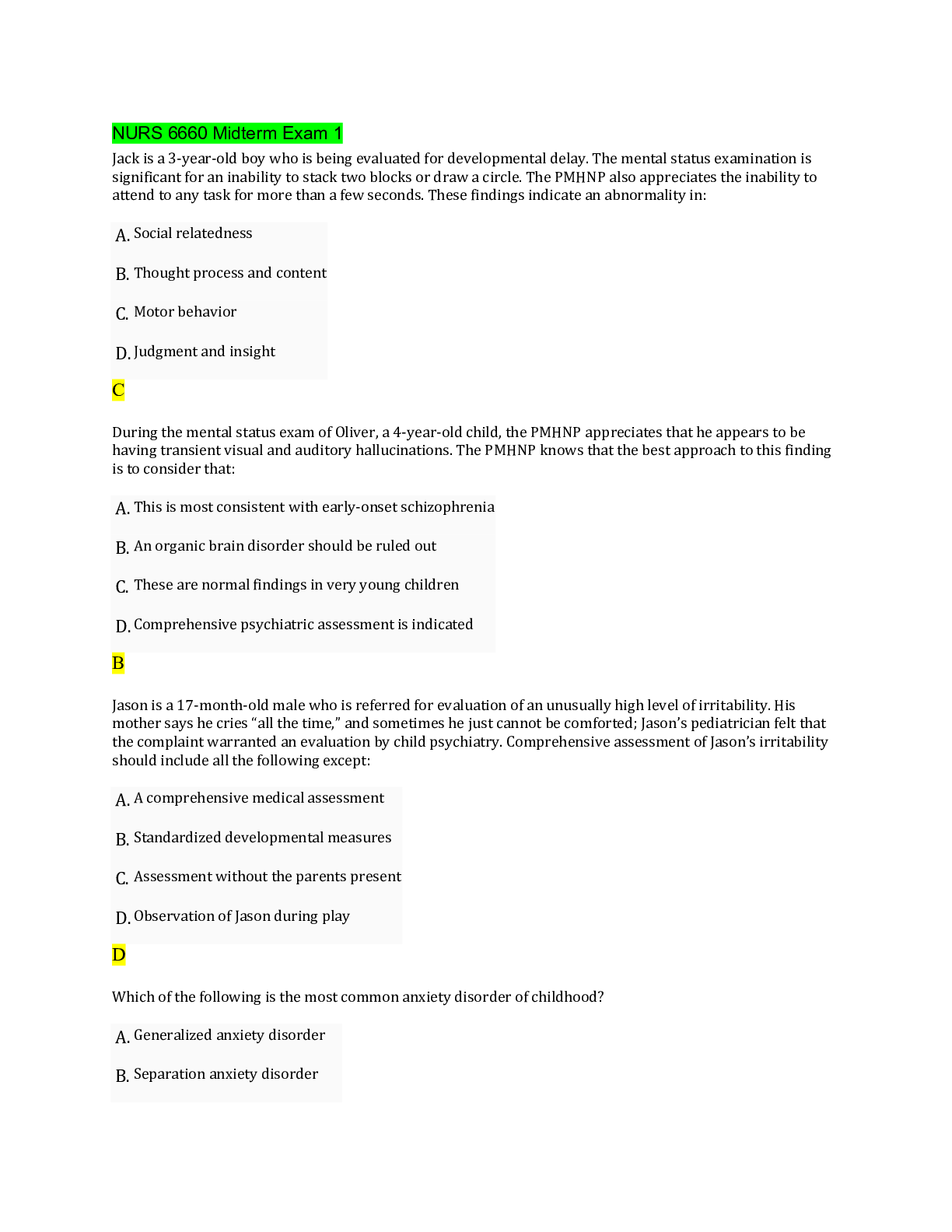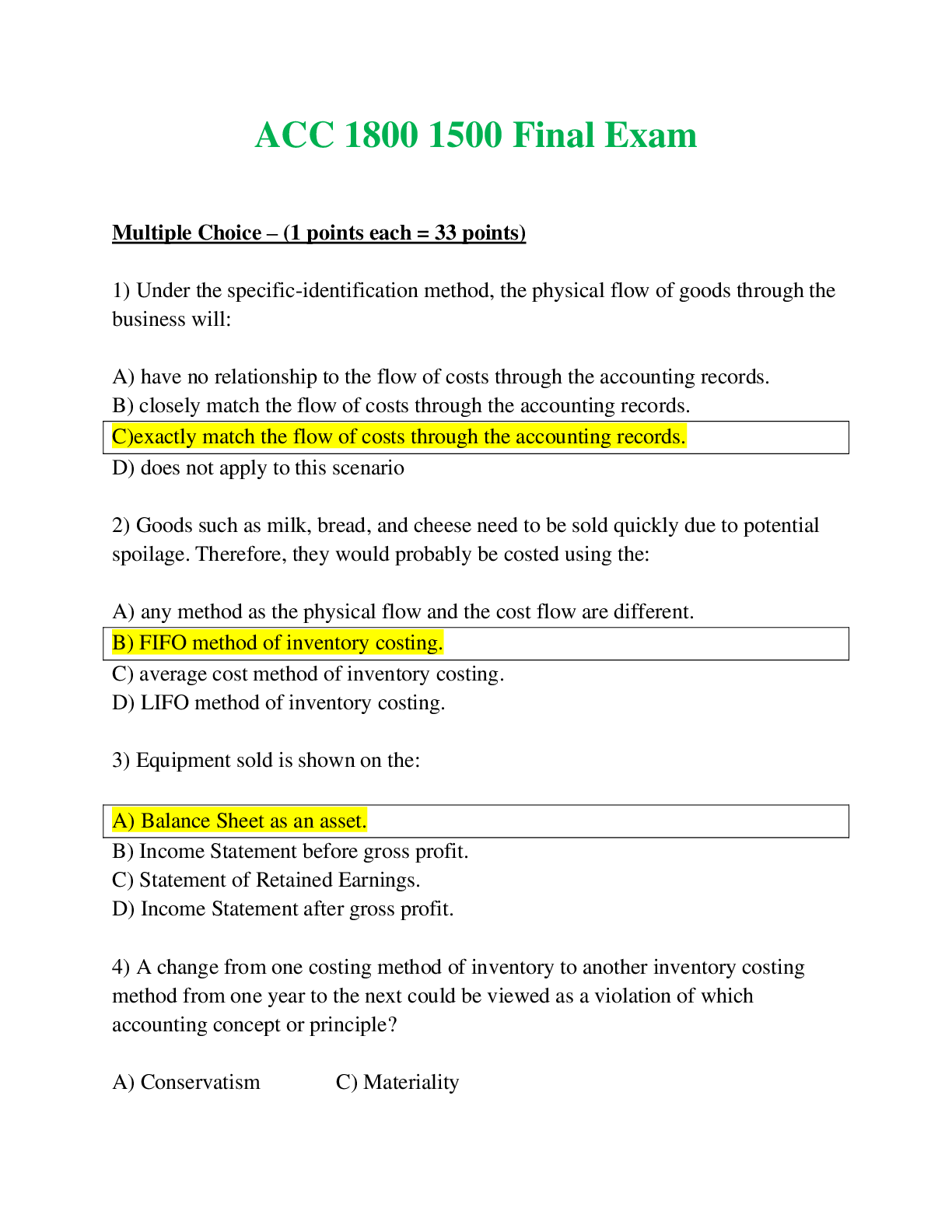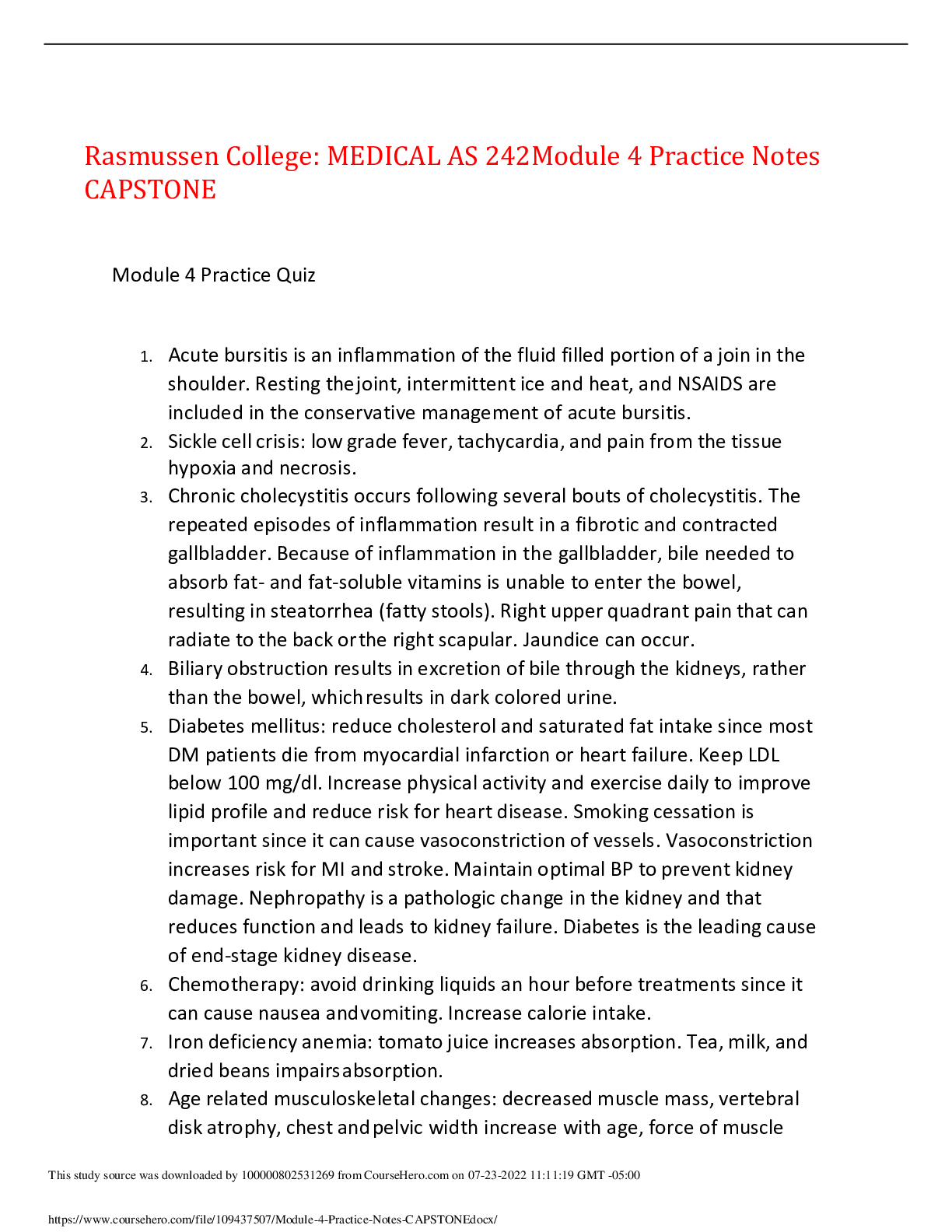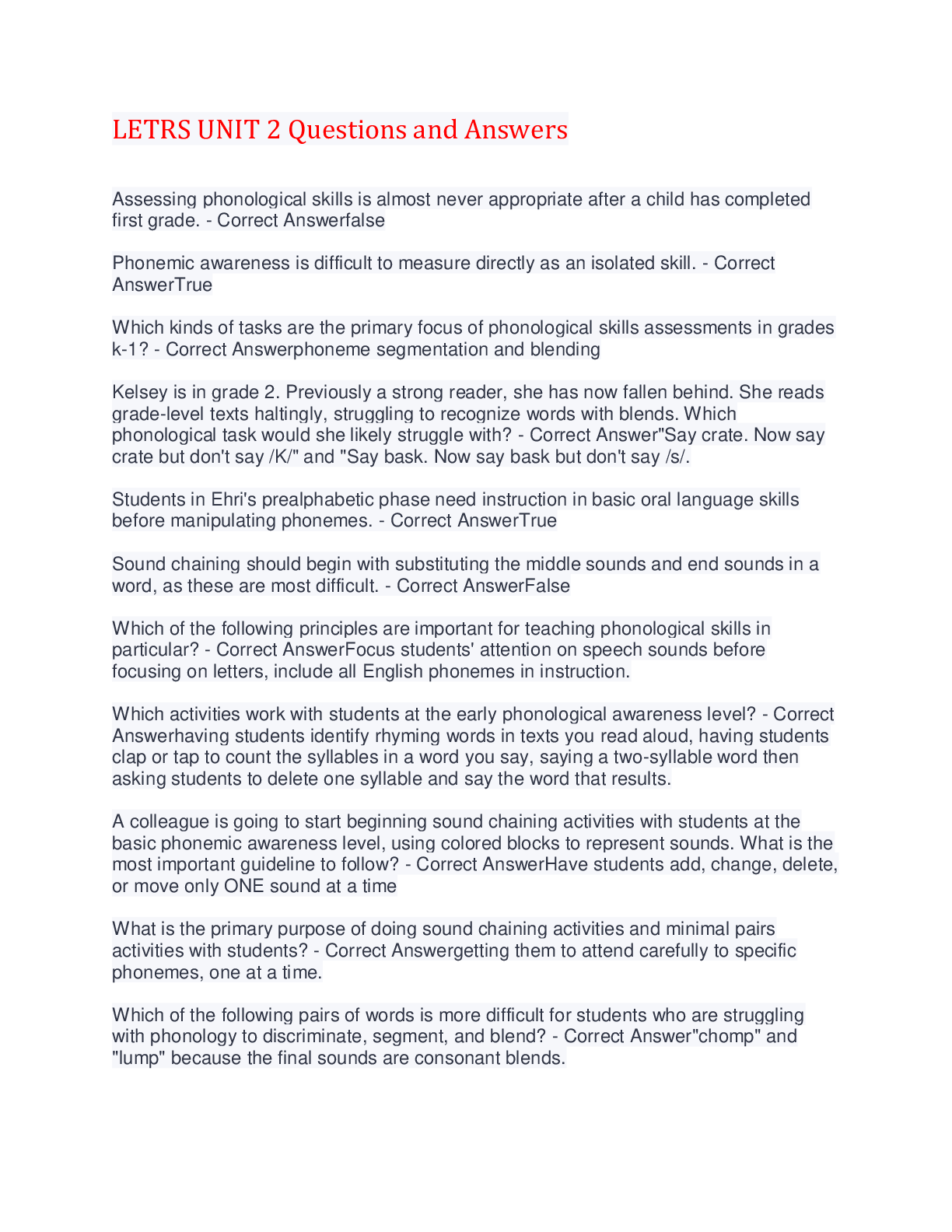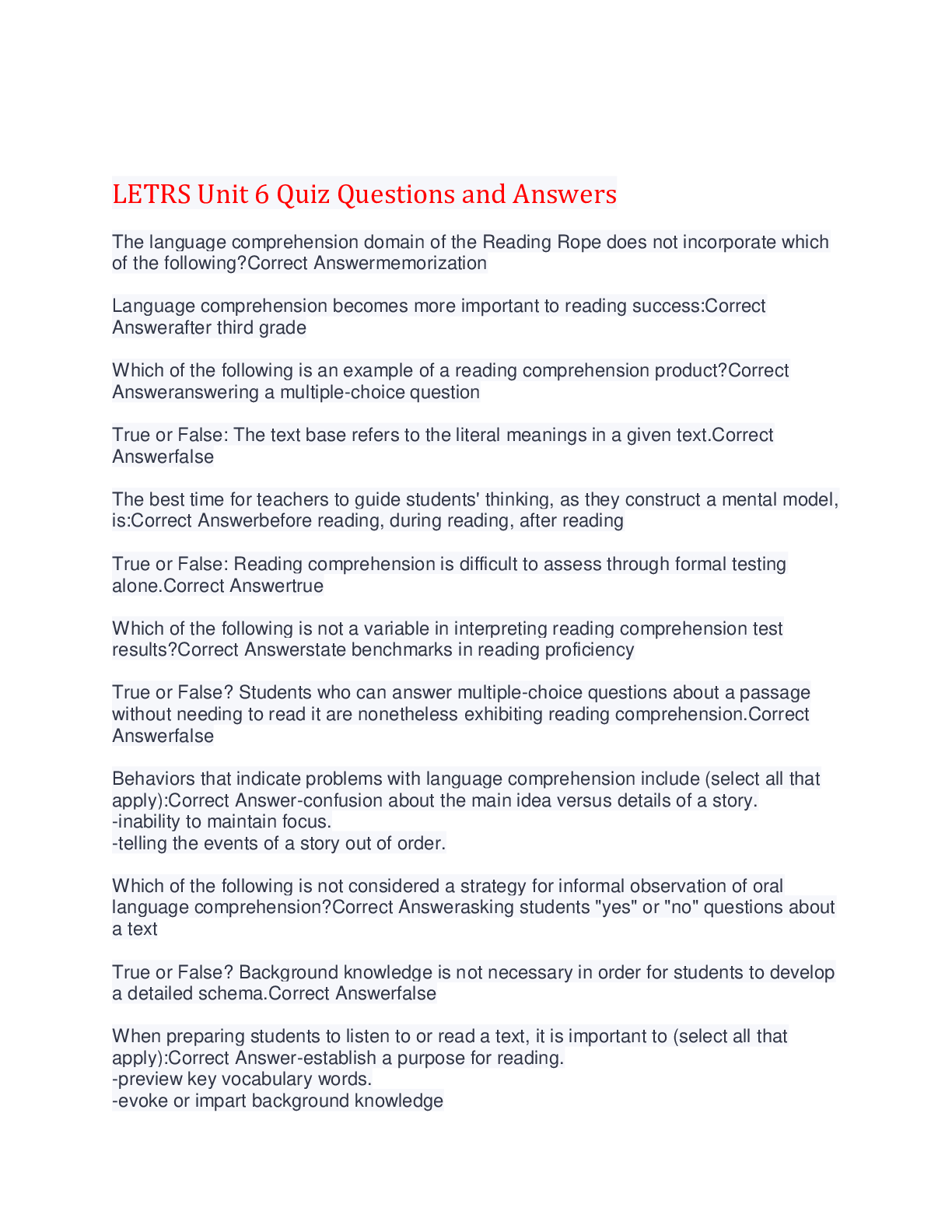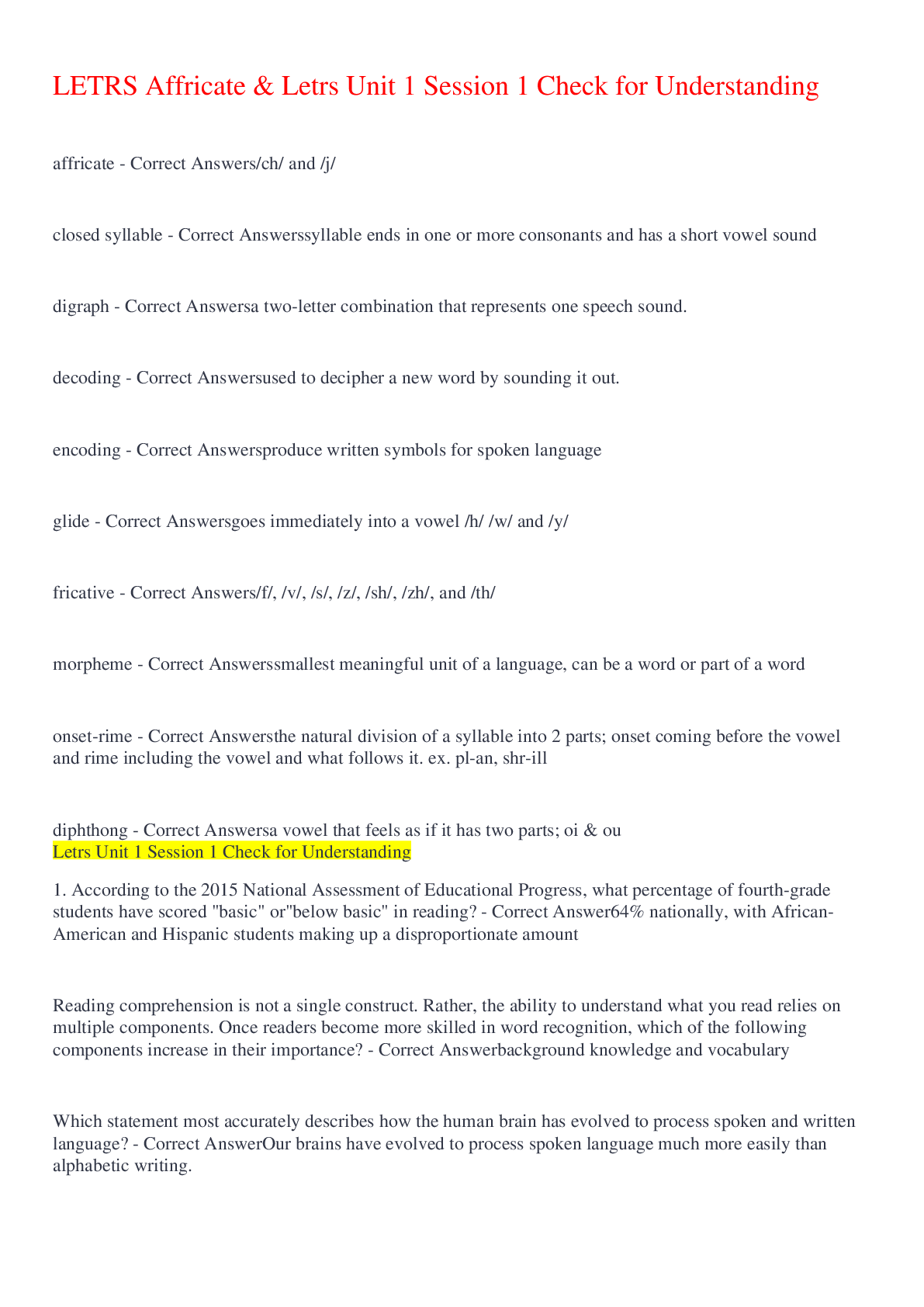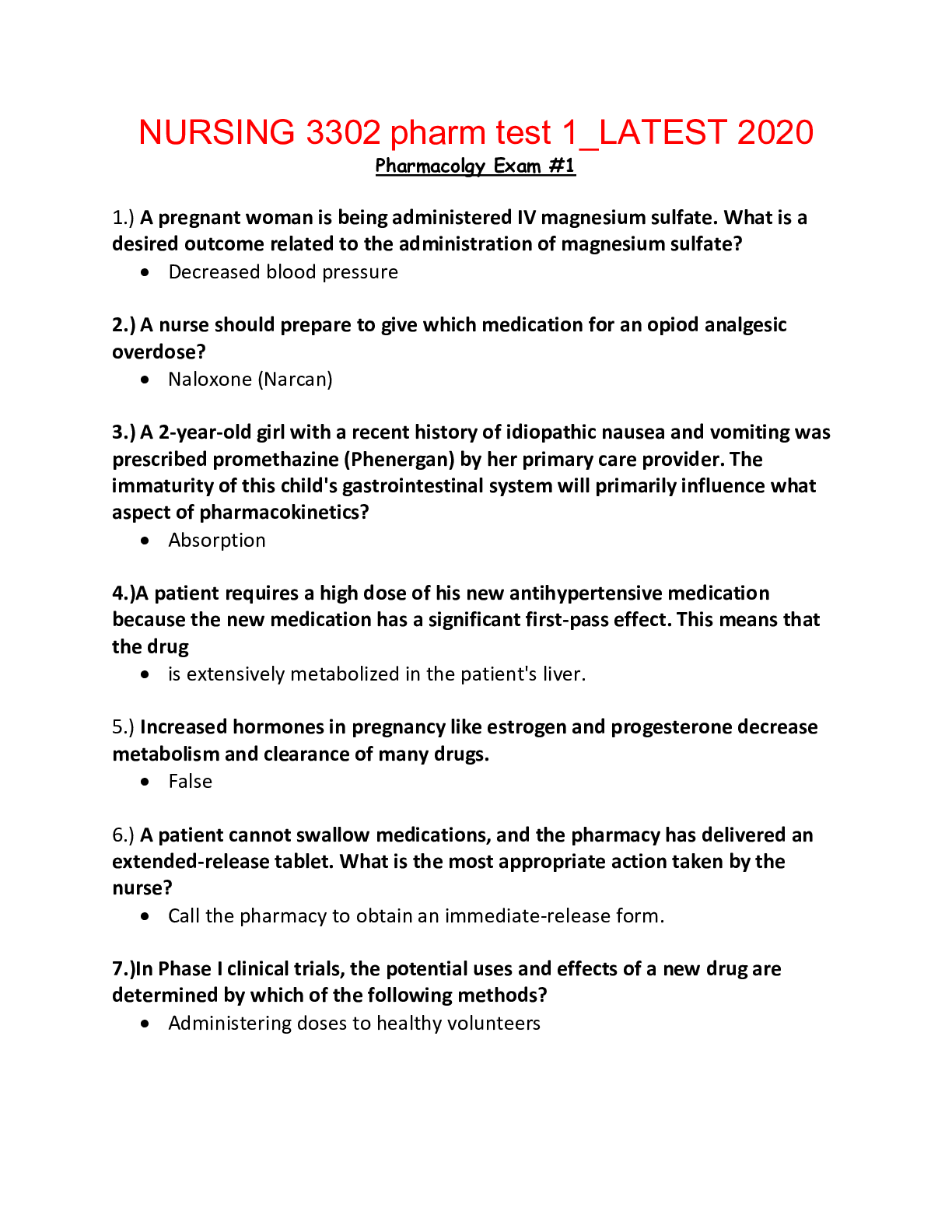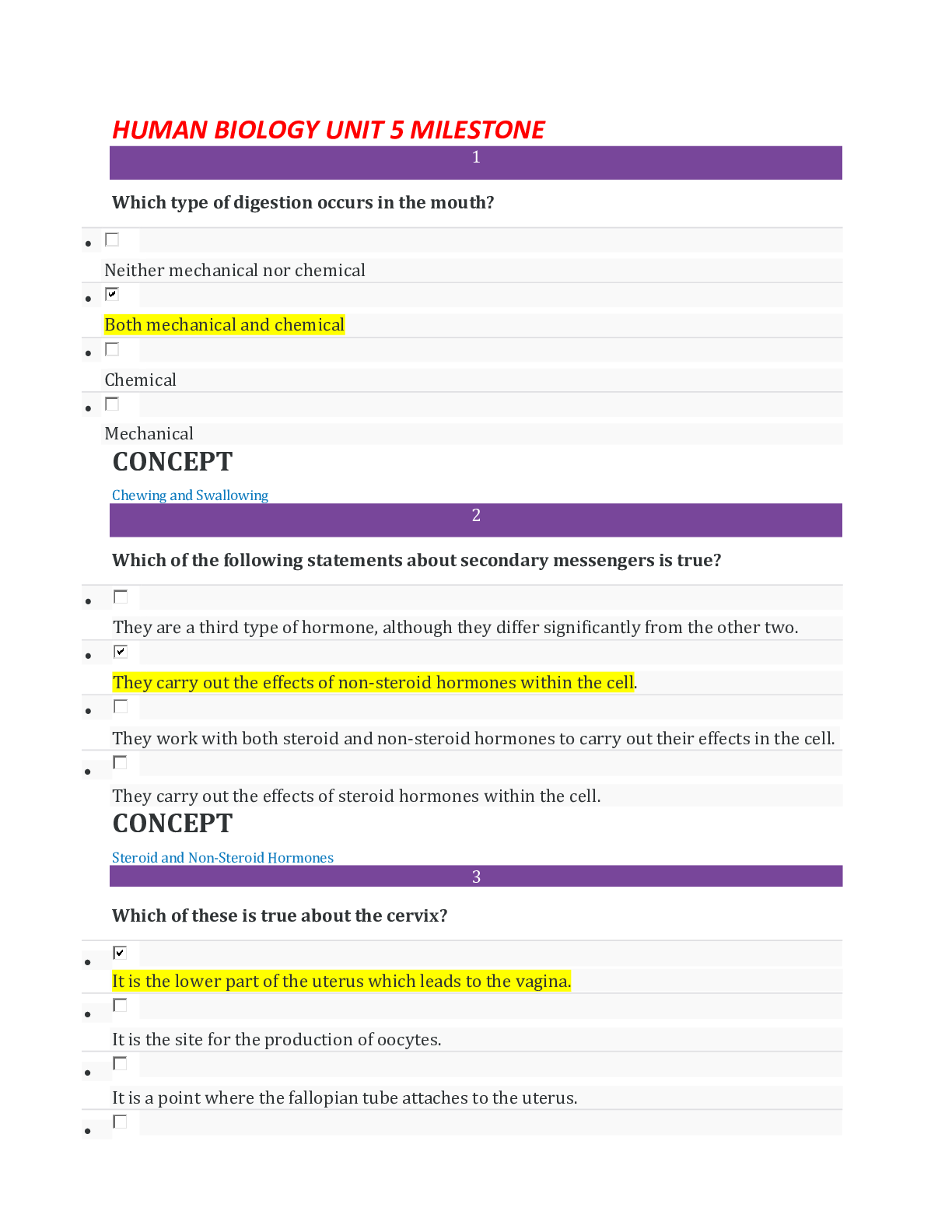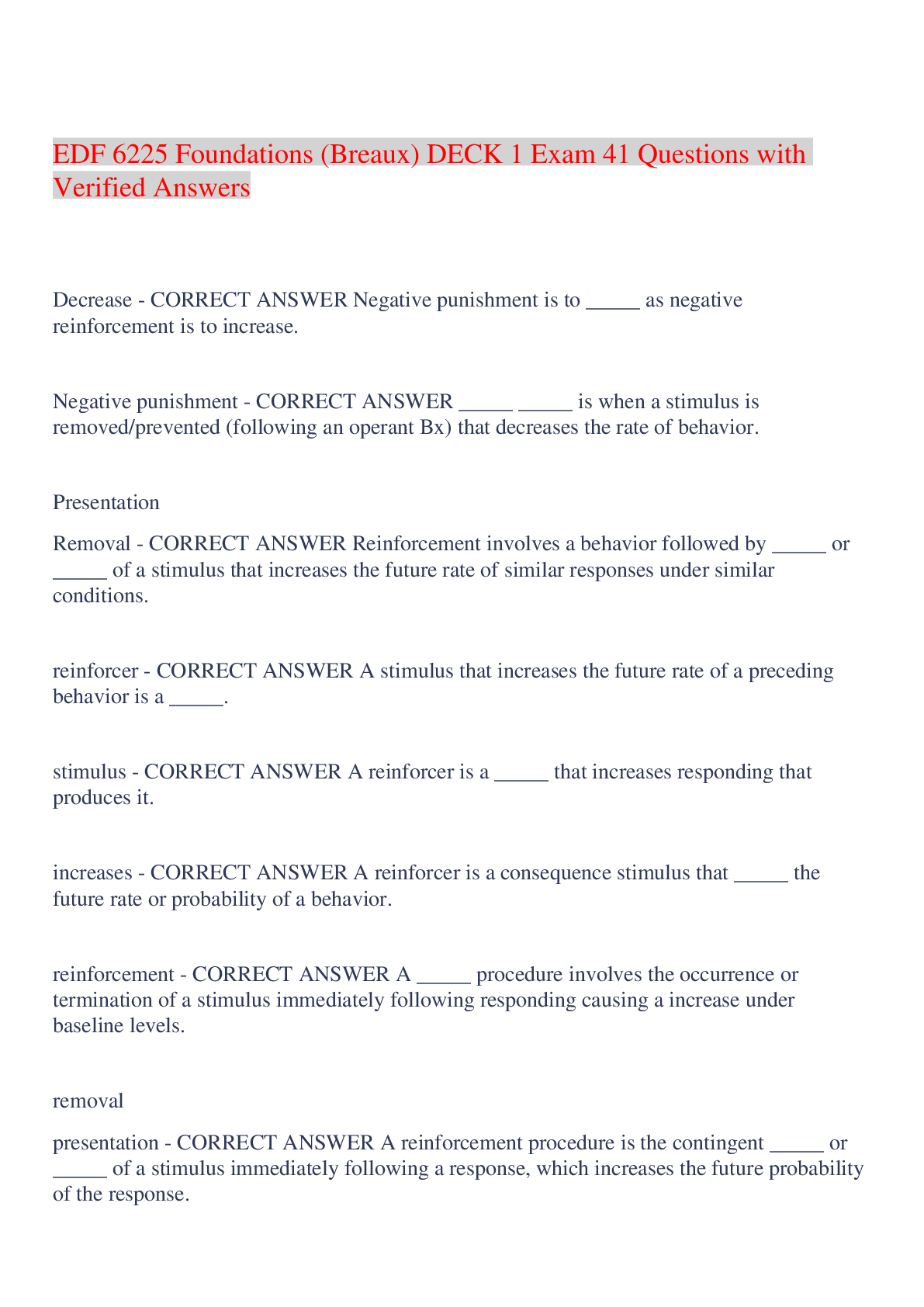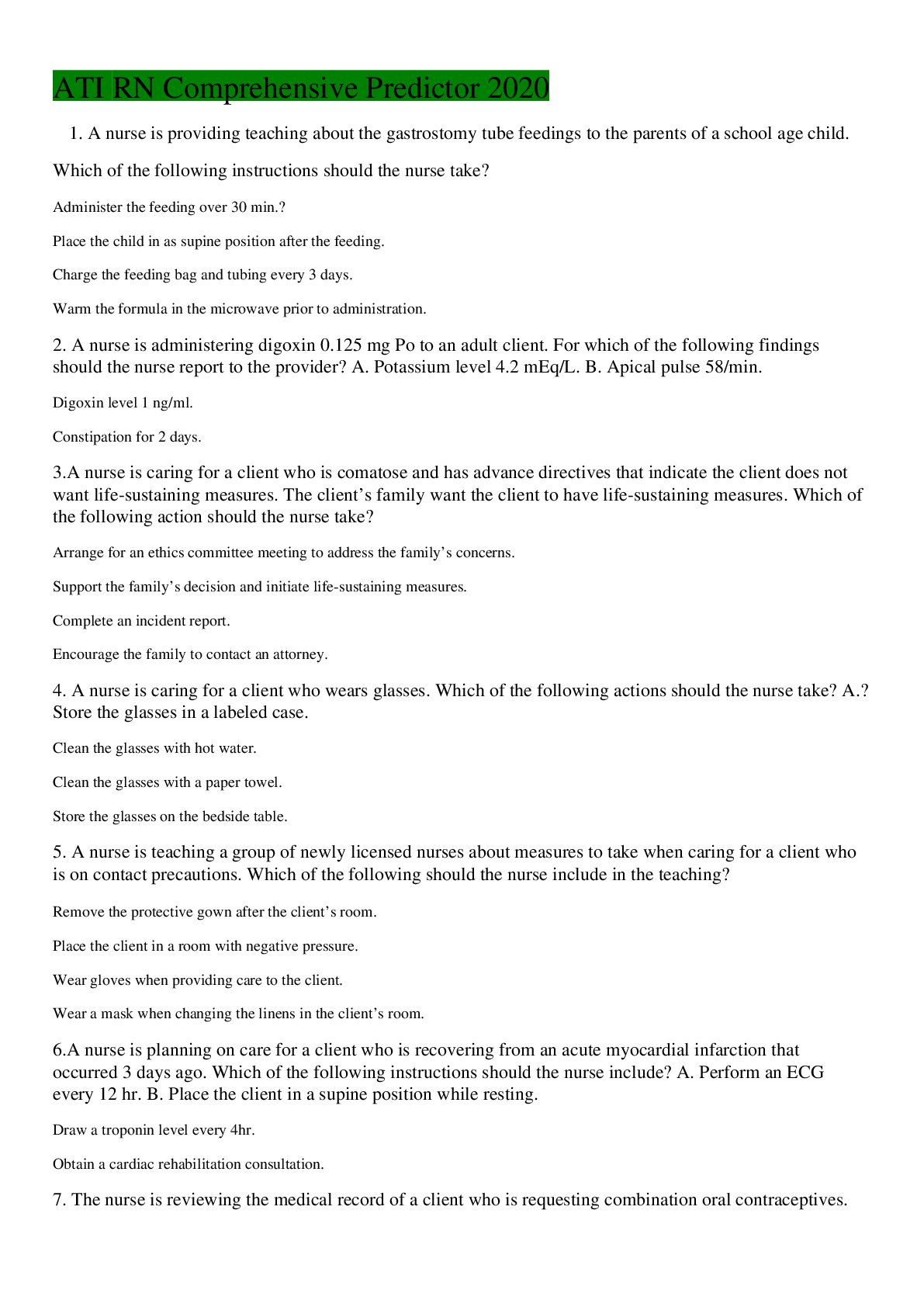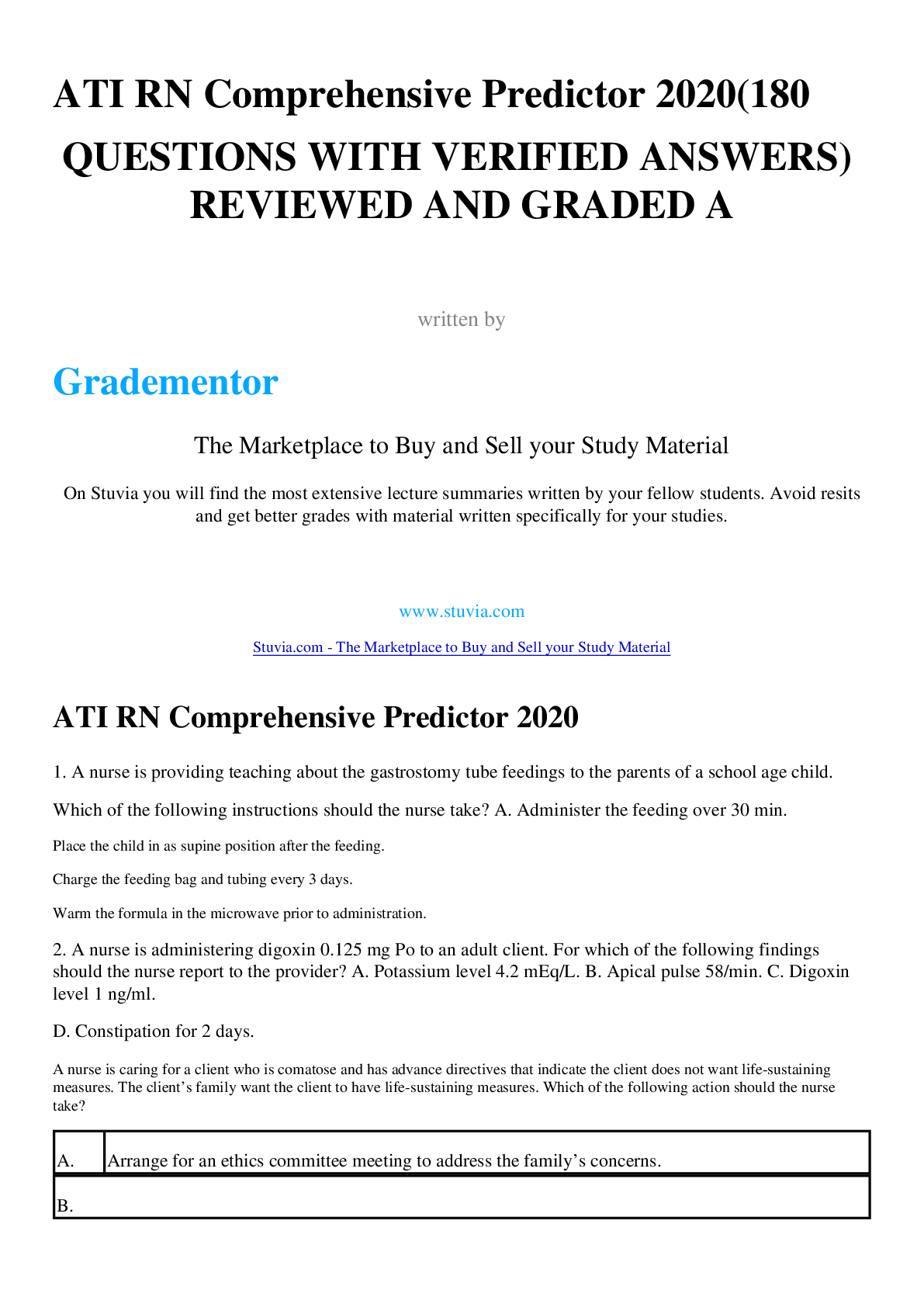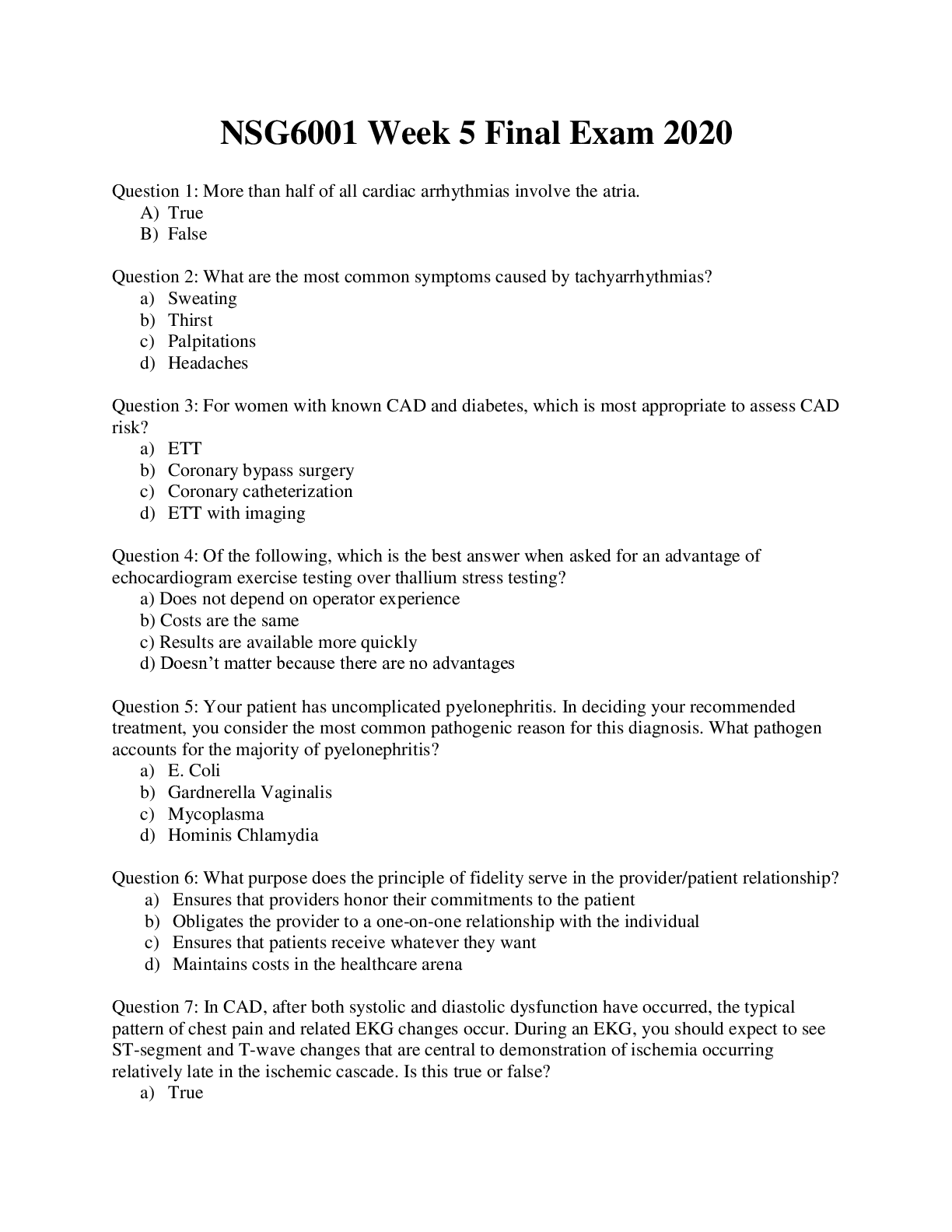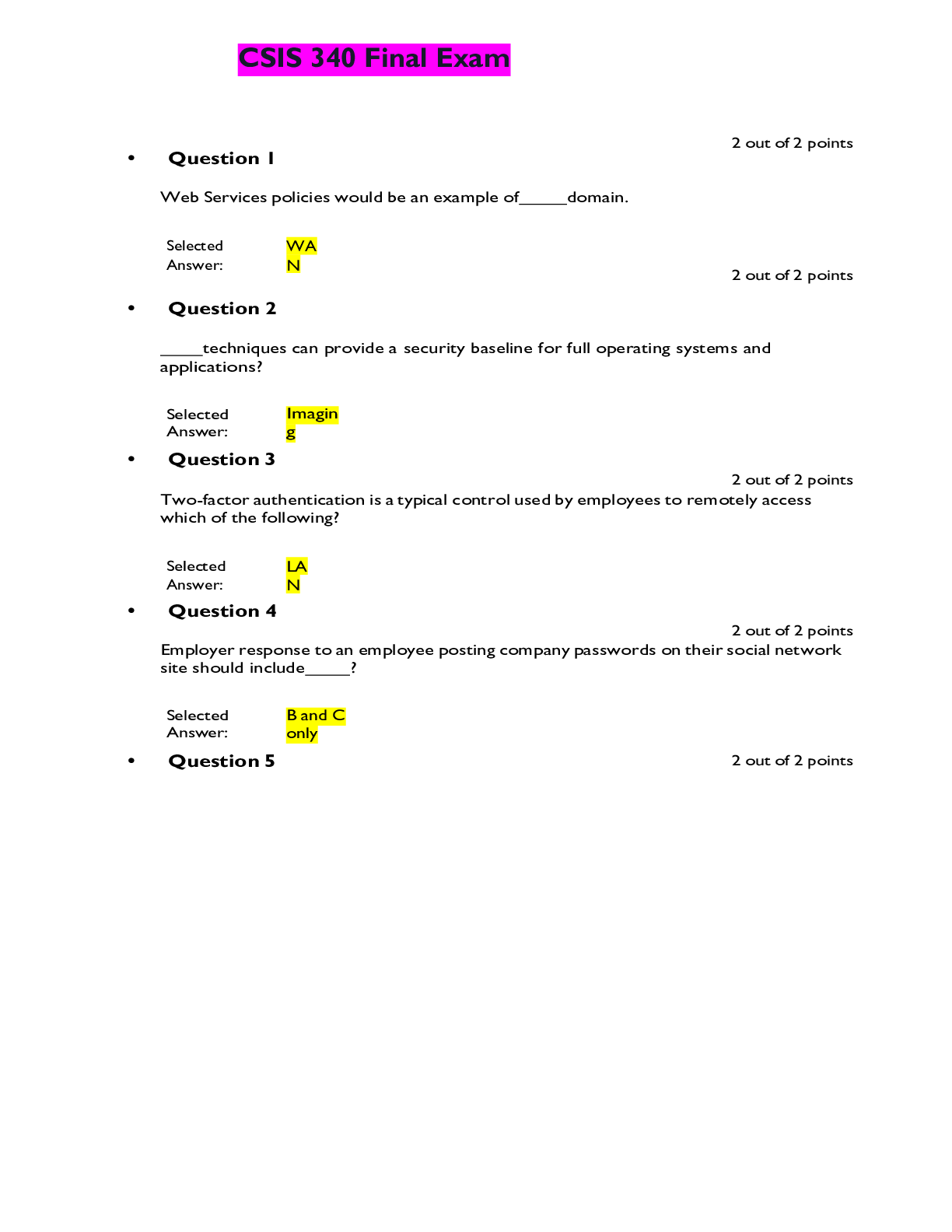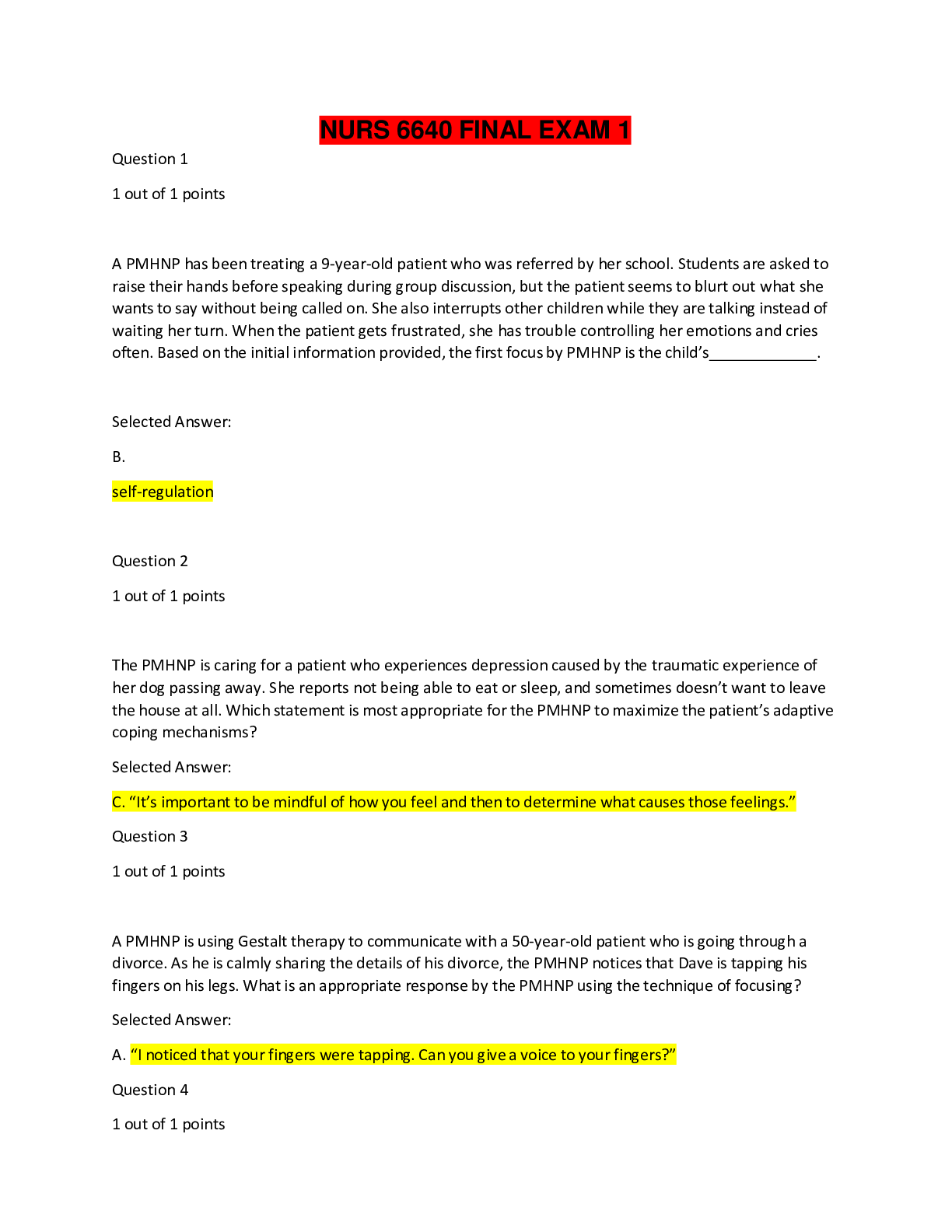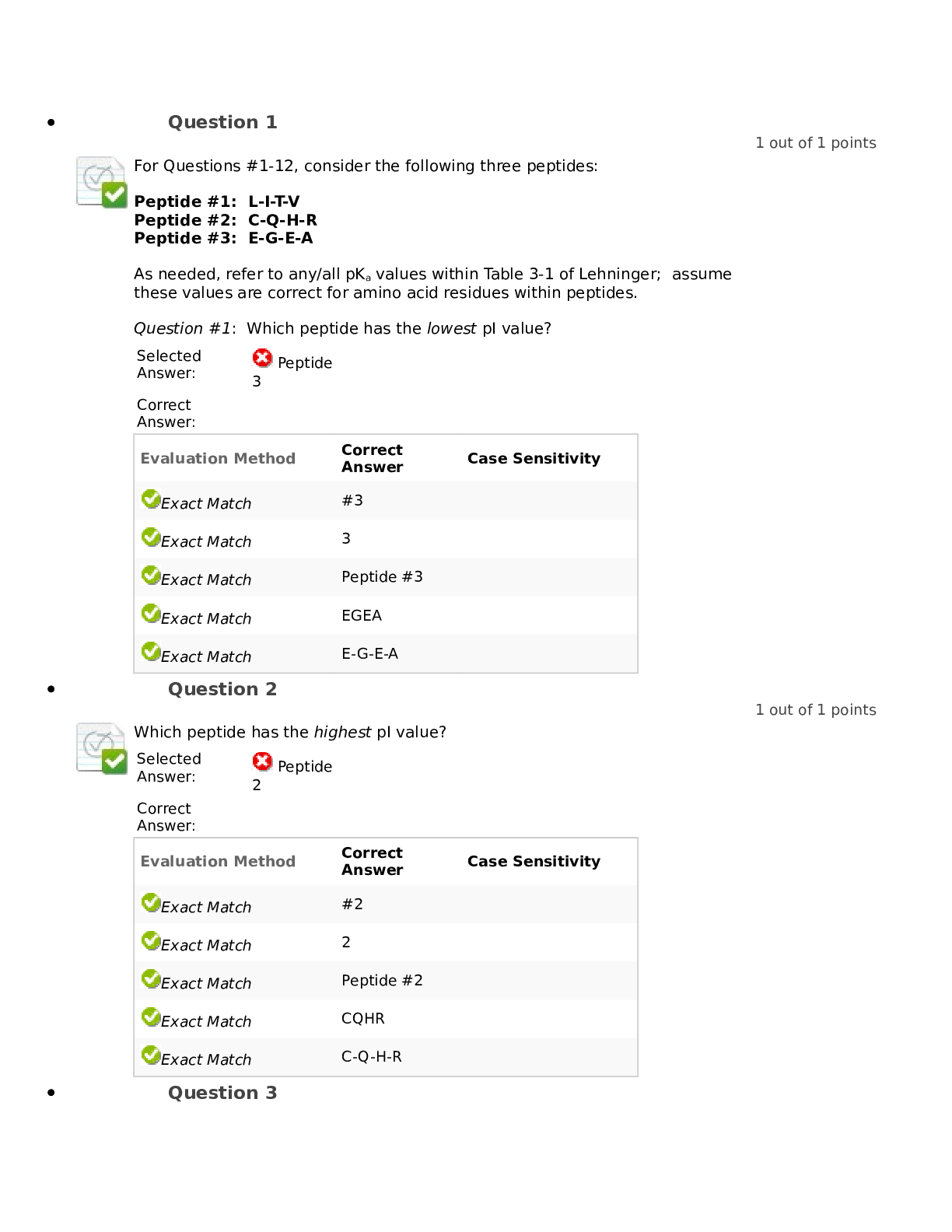EDF 6225 Final Exam 308 Questions with Verified Answers,100% CORRECT
Document Content and Description Below
EDF 6225 Final Exam 308 Questions with Verified Answers BF Skinner - CORRECT ANSWER in preparation for the BCAB certification exam, please know that the material is based on the work of ___________... __ Standard Celeration Chart - CORRECT ANSWER only standardized form of data measurement in our science Dr Ogden Lindsey - CORRECT ANSWER coined the term SAFMEDS circa 1980 to refer to the cards and how to best use them for learning SAFMEDS - CORRECT ANSWER Say All Fast Minute Every Day Shuffle Behavior Analyst Certification Board (BACB) - CORRECT ANSWER - single governing body for professionals in the field of behavior analysis - established in 1998 to provide certification to professionals in an effort to establish minimum criteria to be a reactionary science - CORRECT ANSWER a systematic approach fro seeking and organizing knowledge about the natural world Three levels of understanding - CORRECT ANSWER description, prediction, control descriptive - CORRECT ANSWER studies that produce a collection of facts about the observed events that can be quantified, classified, and examined for possible relations with other known facts correlation - CORRECT ANSWER when a systematic co-variation occurs between two events, we are able to predict the probability that one event will occur in conjunction with the other event control - CORRECT ANSWER - highest level of scientific understanding - specifically manipulate one event in order to produce a reliable change in another event independent variable - CORRECT ANSWER The factor that is manipulated; variable whose effect is being studied dependent variable - CORRECT ANSWER The outcome factor in which we observe change; the variable that may change in response to manipulations of the independent variable Functional Relation - CORRECT ANSWER when one event is specifically manipulated in order to produce a reliable change in another event, and the change in the dependent variable in not likely due to other extraneous factors (confounding variables) dependent variable - CORRECT ANSWER - the "behavior" we wish to change - the change we see in target bx independent variable - CORRECT ANSWER - the "intervention" we employ - the stimuli we manipulate Functional Relation - CORRECT ANSWER when we manipulate the independent variable and see a change in the dependent variable and that change is not likely due to confounding variables determinism - CORRECT ANSWER assumption that the universe is a lawful and orderly place in which phenomena occur as a result of other events Empiricism - CORRECT ANSWER The objective observation of the phenomena of interest Replication - CORRECT ANSWER repeating of experiments to determine the reliability and usefulness of the findings parsimony - CORRECT ANSWER considers the simplest , most logical explanation of a phenomenon before more complex explanations are considered 3 major branches of behavior analysis - CORRECT ANSWER Behaviorism Experimental Analysis of Behavior (EAB) Applied Behavior Analysis (ABA) Experimental Analysis of Behavior - CORRECT ANSWER natural science approach for discovering orderly and reliable relations between behaviors and various types of environmental variables of which it functions. Behaviorism - CORRECT ANSWER the science of behavior that focuses on observable behavior only Applied Behavior Analysis (ABA) - CORRECT ANSWER established by Bear, Wolf, and Risley in 1968 with 7 guiding dimentions Radical Behaviorism - CORRECT ANSWER Attempts to study all behavior, including private events, such as thoughts/feelings, in terms of controlling variables in the history of the person and species. methodological behaviorism - CORRECT ANSWER A philosophical position that views behavioral events that cannot be publicly observed as outside the realm of science. The Behavior of Organisms - CORRECT ANSWER - skinner describes some of his most important research in ____ - describes experiments that demonstrated orderly and reliable relationships between behavior and the environment Applied dimension of ABA - CORRECT ANSWER - Improving the socially significant behaviors of people's lives - Bear et al (1968) : applied research is constrained to examining behaviors which are socially important (socially significant) rather than convenient for study Behavioral dimension of ABA - CORRECT ANSWER behaviors that are observable and measurable Analytic dimension of ABA - CORRECT ANSWER defines how we arrive to our decision as to whether or not behavior change occurred as we predicted technological dimension of ABA - CORRECT ANSWER Defines procedures clearly and in detail so they are replicable Conceptually Systematic Dimension of ABA - CORRECT ANSWER rely on behavioral procedures derived from the research, not just random attempts to change behavior Effective (Dimension of ABA) - CORRECT ANSWER shows that the behavior we selected was objectively measures and it demonstrated a reliable change Generality (Dimension of ABA) - CORRECT ANSWER - golden standard of ABA procedures - when an intervention not only changes behavior in one setting with on person, but maintains across other settings/people positive reinforcement - CORRECT ANSWER when a stimulus is added and future frequencies of behavior maintain or increase positive punishment - CORRECT ANSWER when stimulus is added and future frequencies of behavior decrease negative reinforcement - CORRECT ANSWER when stimulus is removed and future frequencies of behavior maintain or increase negative punishment - CORRECT ANSWER when stimulus is removed and future frequencies of behavior decrease Reinforcement Theory - CORRECT ANSWER a functional theory functional theories - CORRECT ANSWER means all of its components are defined by their function (how they work) structural theories - CORRECT ANSWER means all of its components are defined by their structure (how they look) positive reinforcement - CORRECT ANSWER - a functional relation defined by a two-term contingency - first, a response is followed immediately by the presentation of a stimulus - then, as a result, a similar response occurs more frequently in the future reinforcer - CORRECT ANSWER any stimulus change or event that functions to increase the likelihood of the behavior that led to it delay of reinforcement - CORRECT ANSWER diminishes the intended effects of a stimulus because it allows for another, unintended stimulus to happen prior to the intended stimulus Reinforcement - CORRECT ANSWER changes the function of antecedent stimulus discriminative stimulus (Sd) - CORRECT ANSWER - a stimulus that elicits a response after association with reinforcement - only signals the availability of a reinforcer / not the effectiveness of the reinforcer - refrigerator is always there, it does not make you hungry, it only represents the availability of the reinforcement of food Motivating Operation (MO) - CORRECT ANSWER - increases (EO) or decreases (AO) the current effectiveness of a reinforcer - does not signal the availability of a reinforcer - preference/adverseness of skittles reinforcer - CORRECT ANSWER the refrigerator may typically signal the availability of food and food could be considered a _________ if you are hungry Establishing Operation (EO) - CORRECT ANSWER - A motivating operation that establishes (increases) the effectiveness of some stimulus, object, or event as a reinforcer - food deprivation establishes food as an effective reinforcer - your hunger is not contingent of the availability of the refrigerator (you can be hungry in the absence of a fridge) in this instance your hunger is an _____________ Unconditioned Reinforcer - CORRECT ANSWER - stimulus that, usually, is reinforcing without any prior learning - its effect is due to phylogenic provenance (all members of species are susceptible to the same properties of stimuli) - food, shelter, water, warmth conditioned reinforcer - CORRECT ANSWER - a previously neutral stimulus that gains its reinforcing power through its association with a primary reinforcer - also known as a secondary reinforcer Generalized Conditioned Reinforcer - CORRECT ANSWER a conditioned reinforcer that has a result of having been paired with many unconditioned and conditioned reinforcers does not depended on a current EO for any particular form of reinforcement for its effectiveness contrived reinforcers - CORRECT ANSWER as Skinner (1989) pointed out, the powerful reinforcer "does not need to be contrived for instructional purposes; it is unrelated to any particular kind of behavior and hence always available escape contingency - CORRECT ANSWER when responding terminated an ongoing aversive stimulus avoidance contingency - CORRECT ANSWER when responding delays or prevents the presentation of an aversive stimulus discredited avoidance - CORRECT ANSWER responding in the presence of a signal prevents stimulus presentation free-operant avoidance - CORRECT ANSWER Responding at any time prevents stimulus presentation escape - CORRECT ANSWER removal and reduction of ongoing stimulation typically produce behavior called ___________ behavior avoidance - CORRECT ANSWER postponement and prevention of stimulus presentation produce ________ behavior escape extinction - CORRECT ANSWER as an intervention may actually backfire and shape more dangerous behaviors avoidance/escape - CORRECT ANSWER positively reinforced behavior may compete with, but will not suppress _________ responding that is reinforced concurrently negative reinforcement - CORRECT ANSWER according to Iwatta _________________________ might be considered more intrusive than punishment because, with negative reinforcement, presentation of the aversive stimulus in contingent on the absence, rather than the occurrence, of behavior decreases - CORRECT ANSWER punishment has occurred when a stimulus change immediately follows a response and ________ the future frequency of behavior in similar conditions punishment - CORRECT ANSWER punishment is defined neither by the actions of the person delivering the consequences not by the nature of those consequences. A decrease in the future frequency of occurrence of the behavior much be observed before consequent-based intervention qualifies as __________ negative punishment - CORRECT ANSWER the removal of a stimulus to decrease the probability of a behavior's recurring positive punishment - CORRECT ANSWER the administration of a stimulus to decrease the probability of a behavior's recurring aversive control - CORRECT ANSWER - associated with both positive punishment and negative reinforcement - used to describe interventions involving either or both of these contingencies conditioned punisher - CORRECT ANSWER acquired its punishing properties capabilities by being paired with unconditioned or conditioned punishers punisher - CORRECT ANSWER a stimulus change that immediately follows the occurrence of a behavior and reduces the future frequency of that type of behavior reward ; escape - CORRECT ANSWER Dr. Murry Sidman summarized many times that we consider virtue to be its own ________ . He also indicated that it is a myth to believe that punishment does not teach anything because it effectively teaches avoidance and __________ . positive reinforcement - CORRECT ANSWER punishment much be paired with ________ decrease - CORRECT ANSWER - the power of punishment techniques is that they can rapidly ________ and individual's rate of problem behaviors - merely suppressing unacceptable behaviors is not enough: the individual should also be taught appropriate and functional behaviors removal - CORRECT ANSWER negative punishment has occurred when the frequency of responding has been decreed by the _________ of a stimulus immediately following a behavior response blocking ; negative - CORRECT ANSWER _______________ is when a person or device blocks a response to prevent it from completing, would be considered _________ punishment time out ; negative - CORRECT ANSWER ________ is defined as withdrawal of the opportunity to earn positive reinforcement or the loss of access to positive reinforcers for a specified time. This would be considered ___________ punishment over-correction ; positive - CORRECT ANSWER when, contingent upon a problem behavior, the learner is required to engage in effortful behavior that is directly or logically related to the problem. This would be considered ____________ punishment response cost ; negative - CORRECT ANSWER a form of punishment in which the loss of a specific amount of reinforcement occurs, contingent on an inappropriate behavior, and results in the decreased probability of the future occurrence of the behavior. This would be considered ______ punishment restitutional overcorrection - CORRECT ANSWER after the problem behavior, the learner is required to repair the situation and bring the environment back to a condition that is notably improved than before the behavior occurred response cost - CORRECT ANSWER The contingent loss of reinforcers (e.g. a fine), producing a decrease of the frequency of behavior; a form of negative punishment reinforcing - CORRECT ANSWER time out will typically be ineffective if "time in" is not ________ conditioned punisher - CORRECT ANSWER a stimulus that has acquired its pushing capabilities by being paired with punishers (conditioned or unconditioned) decreases - CORRECT ANSWER punisher is a stimulus change that immediately follows the occurrence of a behavior and _______ the future frequency of that type of behavior ratio strain - CORRECT ANSWER results from abrupt increase in ration requirements when moving from denser to thinner reinforcement schedules interval schedule - CORRECT ANSWER if the contingency b/w responses and reinforcement depends on time, the schedule is call _______ ratio schedule - CORRECT ANSWER in the contingency b/w responses and reinforcement depends on the number of responses, the schedule is call _______ fixed-ratio schedule - CORRECT ANSWER requires a specified number of responses before a response produces reinforcement variable-ratio schedule - CORRECT ANSWER requires a variable number of responses before a response produces reinforcement fixed-interval schedule - CORRECT ANSWER provides reinforcement for the first response following the elapse of variable duration of time since the last reinforced response limited hold - CORRECT ANSWER when reinforcement remains available for a finite time following the elapse of the FI or VI schedule concurrent schedules of reinforcement - CORRECT ANSWER occurs when a) 2 or more contingencies of reinforcement b) operate independently and simultaneously c) for 2 or more behaviors; choice making Multiple Schedule of Reinforcement - CORRECT ANSWER occurs in an alternating , usually random sequence and can be identified by the discriminating stimulus variable-ratio schedule - CORRECT ANSWER requires a variable number of responses before a response produces reinforcement chained schedules - CORRECT ANSWER much like multiple schedules in that it relies on discriminative stimulus; however, the order is not random- it is always the same fixed-interval schedule - CORRECT ANSWER provides reinforcement for the response following the elapse of a specific, constant duration of time since the last reinforced response matching law - CORRECT ANSWER Herrenstein conceptualized the _______ by discovering a near perfect correlation b/w reinforcement and behavior varaible-interval schedule - CORRECT ANSWER provides reinforcement for the first response following the elapse of variable duration of time since the last reinforced response four dimensions of a reinforcer - CORRECT ANSWER rate, quality, delay, and effort Empiricism - CORRECT ANSWER measurement is how we operationalize _______ evidence-based - CORRECT ANSWER at the very foundation of our science, measurement legitimizes our practice so that we can toss around the phrase "_________ ________" with sincerity frequent and accurate - CORRECT ANSWER measurement of behavior ensures that ineffective treatments are not continued and effective treatments are continued three dimensional qualities of behavior - CORRECT ANSWER repeatability, temporal extent, and temporal locus repeatability - CORRECT ANSWER demonstrates the the response can be counted Temporal Extent - CORRECT ANSWER describes the duration of the response temporal locus - CORRECT ANSWER describes the duration b/w the response and some other stimulus in the environment temporal locus - CORRECT ANSWER response latency falls under ________ dimensions of behavior assessment Repeatability - CORRECT ANSWER frequency falls under the _____ dimension of bx measurement Temporal Extent - CORRECT ANSWER duration falls under ______ dimension of bx measurement temporal locus - CORRECT ANSWER inter response time falls under ______ dimension of bx measurement restricted-operant bx - CORRECT ANSWER bx that is built using discrete-trial methods, where a distinct antecedent stimulus is presented and only one response can be emitted free-operant bx - CORRECT ANSWER bx that is not constrained by an antecedent and consequence stimuli for each response; rather, the bx occurs repeatedly and often at a high frequency Frequency - CORRECT ANSWER specific advantage of using free-operant methods in teaching situations is the ability to evaluate ______ percent-correct measure - CORRECT ANSWER unable to evaluate frequency using restricted operants; rather, behavior is typically evaluated according to a ______ Standard Celeration Chart - CORRECT ANSWER frequencies of free-operant responding are best charted on the ______ permanent product - CORRECT ANSWER measuring bx after it has occurred by measuring its effects on the environment is known as measurement by ________ reliable, valid, accurate - CORRECT ANSWER to be useful in science, measurement must be valid - CORRECT ANSWER bx measurement is _____ when the target bx was measured directly, the dimension of the target bx was relevant to the context of the bx, and the data collected were representative of the bx under conditions and during times that were most relevant accurate - CORRECT ANSWER bx measurement is _______ when observed values, the date produced by measuring an event math the true state or values of the event reliable - CORRECT ANSWER bx measurement is _____ when it yields the same values across repeated measurement of the same event observer drift - CORRECT ANSWER - Any unintended change in the way an observer uses a measurement system over the course of an investigation that results in measurement error - can be minimized by constant feedback and monitoring validity ; reliability - CORRECT ANSWER if everyone reports the same measurement, but the measurement instrument is broken, we can say that the measurement procedure lacks ______ , but demonstrated ______ value-altering ; bx-altering - CORRECT ANSWER A motivating operation alters the effectiveness of some stimulus as a reinforcer, which is known as the ___________________________ effect and alters the current frequency of all behavior that has been reinforced by that stimulus, which is known as the ___________________________ effect. frequency - CORRECT ANSWER In addition to___________________________, other aspects of behavior such as response magnitude, latency, and relative frequency can be altered by an MO. value-altering - CORRECT ANSWER The ___________________________ is either an increase in the reinforcing effectiveness of some stimulus (EO) or a decrease in reinforcing effectiveness (AO). unconditioned motivating operations (UMOs) - CORRECT ANSWER "Certain events acquire their value- and behavior-altering effects as a result of the person's evolutionary history" (Langthorne & McGill, 2009, p. 24). This is what we call ___________________________. history ; paired - CORRECT ANSWER Just as in unconditioned reinforcers, UMOs do not require a learning ___________________________ to be established. On the other hand, Conditioned Motivating Operations (CMOs) are value- and behavior-altering events that are a result of the person's learning history. Just like conditioned reinforcers, they acquire their status by being___________________________ with their unconditioned (or another previously paired conditioned) counterpart. increase ; frequency - CORRECT ANSWER When food deprivation is an establishing operation, the value-altering effect is an ___________________________ in the reinforcing effectiveness of food. The behavior- altering effect is an increase in the current ___________________________ of all behavior that has been reinforced by food. availability - CORRECT ANSWER A discriminative stimulus controls a type of behavior because it has been related to the differential ___________________________ of a reinforcer for that type of behavior. increases - CORRECT ANSWER When the environmental event is "becoming too warm", it ___________________________ the current frequency of all behavior that has been reinforced by becoming cooler. value-altering ; bx-altering - CORRECT ANSWER In the establishing operation, the ___________________________ is an increase in the current effectiveness of some stimulus, object, or event as reinforcement. The ___________________________ is a increase in the current frequency of all behavior that has been reinforced by that stimulus, object, or event. discriminative stimulus ; motivation operations - CORRECT ANSWER ___________________________ are related to the differential availability of a currently effective form of reinforcement for a particular type of behavior; ___________________________ are related to the differential reinforcing effectiveness of a particular type of environmental event. conditioned motivating operations (CMOs) - CORRECT ANSWER Motivating variables that alter the reinforcing effectiveness of other stimuli, objects, or events, but only as a result of the organism's learning history, are called ___________________________. surrogate - CORRECT ANSWER ___________________________ CMO is a stimulus that acquires its MO effectiveness by being paired with another MO, and has the same value-altering and behavior-altering effects as the MO with which it was paired. reflexive - CORRECT ANSWER ___________________________ CMO is a stimulus that acquires MO effectiveness by preceding some form of worsening or improvement. transitive - CORRECT ANSWER An environmental variable that establishes (or abolishes) the reinforcing effectiveness of another stimulus and evokes (or abates) the behavior that has been reinforced by that other stimulus is a ___________________________ CMO. availability - CORRECT ANSWER An SD controls a type of behavior because it has been related to the differential ___________________________ of an effective reinforcer for that type of behavior. value-altering - CORRECT ANSWER ___________________________ is either an increase in the reinforcing effectiveness of some stimulus (EO) or a decrease in reinforcing effectiveness (AO). decrease ; frequency - CORRECT ANSWER In the abolishing operation, the value-altering effect is a ___________________________ in the current effectiveness of some stimulus, object, or event as reinforcement. The behavior-altering effect is a decrease in the current ___________________________ of all behavior that has been reinforced by that stimulus, object, or event. Establishing operation -> discriminative stimulus -> response -> reinforcing stimulus - CORRECT ANSWER The temporal order of the 4-term contingency of positive reinforcement consists of: Automatic reinforcement - CORRECT ANSWER involves the reinforcement occurring independent of another person delivering it conditioned - CORRECT ANSWER __________ reinforcers are established based on a history of pairing with established reinforcers. unconditioned reinforcer - CORRECT ANSWER Stimuli that do not require a learning history to acquire reinforcing qualities are known as reinforcer assessments - CORRECT ANSWER ______________ can be used to experimentally verify whether stimuli identified as highly preferred do indeed function as reinforcers. Premack Principle (Grandma's Rule) - CORRECT ANSWER Arranging high-frequency (ie., high preference) activities to follow low-frequency (ie., low preference) activities is an application of false ; they reinforce bx - CORRECT ANSWER Behavior analysts reinforce people. true - CORRECT ANSWER A behavior is reinforced, not the person. reinforcer - CORRECT ANSWER The stimulus change responsible for the increase in responding is called: true - CORRECT ANSWER In addition to increasing the future frequency of the behavior it follows, reinforcement changes the function of antecedent stimuli. discriminative stimulus - CORRECT ANSWER An antecedent stimulus that evokes behavior because it has been correlated with the availability of reinforcement is called a(n) ________. false - CORRECT ANSWER Humans must be able to connect the behavior and the reinforcing consequence in order to be effective, due to their language ability. Other organisms do not need to connect the behavior and the reinforcing consequence. Generalized Conditioned Reinforcer - CORRECT ANSWER A _________ is a conditioned reinforcer that does not depend on a current establishing operation for any particular form of reinforcement for its effectiveness. escape ; avoidance - CORRECT ANSWER Removal and reduction of ongoing stimulation typically produce behavior that is called _____________ whereas postponement and prevention of stimulus presentation produce behavior that is called _____________. - ensure that the teaching technique is varied and not aversive - ensure that the demand is not too difficult - ensure that the demand is not too easy all of the above - CORRECT ANSWER To avoid shaping more dangerous escape maintained behaviors in educational settings, the person intervening should: true - CORRECT ANSWER According to Osborne's 1969 study, Iwata indicated that free time could either be defined as the availability of preferred activities or the termination of non-preferred activities. false - CORRECT ANSWER When a student exhibits an undesirable, but not dangerous behavior when presented with a demand, it is recommended that you ignore the minor behavior and prevent escape in order to extinguish the behavior. true - CORRECT ANSWER Positive reinforcement for compliance alone does not suppress avoidance-motivated self-injury. produce increase in future bx - CORRECT ANSWER Positive reinforcement and negative reinforcement both termination of the aversive stimulus - CORRECT ANSWER In negative reinforcement, the reinforcer is the removed ; increases - CORRECT ANSWER Negative reinforcement can be defined as: A stimulus _______, contingent upon a response, which _______ the future probability of that response. Which of the following is an example of a negative reinforcement contingency? - CORRECT ANSWER Jo is sitting near a window at Starbucks having a cup of coffee. The sun is streaming in the window, and it is too warm for Jo-she is beginning to perspire. Jo moves to another chair away from the window, where it is shady. The next time Jo goes to Starbucks, she sees the sun shining in the window again and sits in the chair in the shade instead. The key difference between an escape contingency and an avoidance contingency is: - CORRECT ANSWER In an escape contingency the EO is present prior to the occurrence of the target behavior, while in an avoidance contingency, the EO is not present prior to the occurrence of the target behavior. - stimulus change following the occurrence of the target behavior was immediate. - difference in stimulation prior to and after the response occurred was large. - occurrence of the target response consistently produced escape. - Reinforcement was unavailable for competing responses all of the others - CORRECT ANSWER The textbook describes a study by Ahearn and colleagues (1996), in which negative reinforcement was used to increase food acceptance in children. In this example, during baseline, bite acceptances produced access to toys and bite refusals produced removal of the spoon (negative reinforcement). During the intervention, bite refusals no longer produced removal of the spoon. Instead, the spoon was only removed if a bite was accepted. As soon as a bite was accepted and every time a bite was accepted, the spoon was briefly removed. Which factors are important to consider for effectively changing behavior with negative reinforcement are illustrated in this example? punishment - CORRECT ANSWER The potential negative side effects (e.g., crying, running away) of negative reinforcement are similar to the side effects associated with: positive punishment can be defined as: - CORRECT ANSWER Delivery of a stimulus after a behavior that decreases the occurrence of the behavior. restitutional overcorrection - CORRECT ANSWER Mrs. Mody decided that because Johnny dumped the contents of his glue container on the floor that he would not only have to clean up his work space, but clean the entire classroom floor. The punishment procedure that Mrs. Mody is using is called: false - CORRECT ANSWER A conditioned reinforcer is a punishing stimulus that has acquired its properties as a function of species history. true - CORRECT ANSWER According to Sidman (1993), ineffective teaching produces and exacerbates problem behavior. true - CORRECT ANSWER Punishment is defined neither by the actions of the person delivering the consequences nor by the nature of those consequences (e.g., time-out). positive punishment - CORRECT ANSWER ____________ has occurred when the frequency of responding has been decreased by the presentation of a stimulus. unconditioned punisher - CORRECT ANSWER A(n) ____________ is a punishing stimulus that has acquired its properties as a function of species history. teacher - CORRECT ANSWER Which of the following could function as conditioned punisher (the other three are typically unconditioned punishers)? a shock - CORRECT ANSWER Which of the following is an example of an unconditioned punisher? breaks - CORRECT ANSWER Which of the following is NOT a schedule of reinforcement? both FR1 and continuous reinforcement - CORRECT ANSWER In which schedule of reinforcement is an individual reinforced every time a particular behavior occurs? intermittent reinforcement - CORRECT ANSWER In what type of schedule are environmental arrangements developed in which some occurrences of a behavior will be reinforced and other occurrences of the same behavior will not be? FR3 - CORRECT ANSWER The pitcher walks a baseball player every 3rd time up at bat. This is an example of what schedule of reinforcement? variable ratio - CORRECT ANSWER Reinforcement that occurs after an average of 5 correct responses is an example of what schedule of reinforcement? varaible interval - CORRECT ANSWER Reinforcement that occurs contingent on the first correct response after an average 5 minutes is an example of what schedule of reinforcement? concurrent - CORRECT ANSWER Two or more contingencies of reinforcement that operate independently and simultaneously for two or more behaviors constitute what schedule of reinforcement? multiple - CORRECT ANSWER What schedule presents two or more basic schedules of reinforcement associated with distinct discriminative stimuli for a single behavior class in an alternating, usually random, sequence? chained - CORRECT ANSWER What schedule presents two or more basic schedules of reinforcement associated with distinct discriminative stimuli in a predictable sequence? chained - CORRECT ANSWER In what schedule is the conditioned reinforcer for one response the discriminative stimuli for the next response? mixed - CORRECT ANSWER What non-discriminative schedule presents two or more basic schedules of reinforcement for a single behavior class in an alternating, usually random, sequence? alternative - CORRECT ANSWER Both an FI 5 and an FR 25 are in effect. The individual produces her 14th target response after 5 minutes and receives reinforcement. What schedule of reinforcement is she in? conjunctive - CORRECT ANSWER Both an FI 5 and an FR 25 are simultaneously in effect. The individual produces his 14th target response after 5 minutes but does not receive reinforcement until he produces 25 target responses. What schedule of reinforcement is he in? variable interval - CORRECT ANSWER Social media has thickened the reinforcement schedule considerably. Logging in to Facebook to check how many people "like" your newly posted photo of a night on the town is an example of what schedule? Density and quality of reinforcement available in the time-in environment - CORRECT ANSWER The effectiveness of timeout is largely determined by: No. The time-out environment is more reinforcing than the aversive math exam. Placing him in time out will likely increase this behavior on the next exam. - CORRECT ANSWER Mrs. Smith placed Timmy in time-out because he refused to pick up his pencil to take his math test. Previous behavior assessments have demonstrated that the function of his non-compliance in math was typically escape maintained. Was this intervention appropriate? true - CORRECT ANSWER According to the matching law, as reinforcer deliveries increase along the x-axis, proportional increases in behavior are depicted along the y-axis. true - CORRECT ANSWER By applying the matching law, you can utilize differential reinforcement without employing extinction on the inappropriate behavior. positive ; reinforcement - CORRECT ANSWER Herrnstein found a near-perfect, ________ correlation between one unit increase in ________ with one unit increase in behavior. response class - CORRECT ANSWER ___________ are all the topographical forms of the performance that have a similar function. consequences - CORRECT ANSWER ________________ are stimulus changes after the behavior. true - CORRECT ANSWER A stimulus class has a common effect on behavior, but can vary based on their topographical properties. dependent varaible - CORRECT ANSWER In a functional relation, the ______________ is the behavior that was changed. Herrnstein's Matching Law - CORRECT ANSWER independent varaible - CORRECT ANSWER In a functional relation, the ______________ is the intervention - goals - focus - methodology all of the above - CORRECT ANSWER Applied Behavior Analysis is set apart from other disciplines devoted to the understanding and improvement of human behavior with respect to its: false - CORRECT ANSWER The term "applied" in ABA means that technology is applied to a research question. false - CORRECT ANSWER S-R psychology is a paradigm for modern behaviorism Applied Behavior Analysis seeks to produce statistically significant results - CORRECT ANSWER Which of the following is not a component specified in the definition of ABA? Prediction, Description, and Control - CORRECT ANSWER Different types of scientific investigations yield 1 or more of three levels of understanding of phenomena under study. These are: Experimentation, Philosophic Doubt, & Parsimony - CORRECT ANSWER Scientific "attitudes" as described by Skinner include: respondent behavior. - CORRECT ANSWER Behavior that is elicited by antecedent stimuli is referred to as: a reflex incules: - CORRECT ANSWER An eliciting stimulus and the behavior it produces. - their relationship to controlliing variables - a set of contingencies - their consequences all of the above - CORRECT ANSWER Operants must be defined in terms of (check all that apply): operant behavior - CORRECT ANSWER Behavior whose probability of occurrence is determined by its history of consequences is: The rate of the given behavior will immediately increase - CORRECT ANSWER Which of the following is NOT part of the definition of a behavioral consequence: negative reinforcement - CORRECT ANSWER When certain stimuli increase the future probability of a behavior when they are terminated immediately following a response, what has occurred is termed: negative reinforcement - CORRECT ANSWER The future probability of Ken completing homework increased when his parents required Ken to remain at his desk until his homework was completed. This is an example of: perception of the stimulus - CORRECT ANSWER Which of the following is NOT a component of the three term contingency? different histories of reinforcemnt - CORRECT ANSWER Differences in the way we respond to situations are primarily the result of: Respondent behavior is: - CORRECT ANSWER elicited by antecedant events true - CORRECT ANSWER Although other fields aim to understand and improve human behavior, Applied Behavior Analysis distinguishes itself by its focus, goals, and methods. true - CORRECT ANSWER The three levels of scientific understanding are: describe, predict, and control applied - CORRECT ANSWER Which characteristic of ABA refers to the commitment to affecting improvements in behaviors that enhance and improve people's lives? technological - CORRECT ANSWER Which characteristic of ABA refers to clarity in its methodology? generality - CORRECT ANSWER Which characteristic of ABA refers to a behavior change that either lasts over time or appears in novel environments? conceptually systematic - CORRECT ANSWER An intervention that is ____________ will define the behavior change as it was derived from basic principles of ABA, not a "bag of tricks". independent variable; dependent variable; functional relation - CORRECT ANSWER Results of experiments that show that specific manipulations of one event, or the ___________________ produce a reliable change in another event, or the ________________ and that change was unlikely due to confounding variables is an example of a(n) _________________. dependant variable - CORRECT ANSWER In a functional relation, the ______________ is the behavior that was changed. independent varaible - CORRECT ANSWER In a functional relation, the ______________ is the intervention true - CORRECT ANSWER Determinism is the assumption that the universe is a lawful and orderly place in which phenomena occur as a result of other events. false - CORRECT ANSWER Free will is compatible with determinism. true - CORRECT ANSWER The independent variable is the intervention in a functional relation. false - CORRECT ANSWER The dependent variable is the intervention in a functional relation. Methodological behaviorism; radical behaviorism - CORRECT ANSWER ______________ is a philosophical position that considers behavior events that cannot be publicly observed to be outside the realm of science; ________________ attempts to explain all behavior, including private events such as thinking and feeling. false - CORRECT ANSWER Radical behaviorism is a philosophical position that considers behavioral events that cannot be publicly observed to be outside the realm of the science. true - CORRECT ANSWER Food and water are considered unconditioned reinforcers false - CORRECT ANSWER Your sister can be an unconditioned punisher. false - CORRECT ANSWER Non-compliance is a response. true - CORRECT ANSWER Breaststroke and backstroke are topographically different, but are members of the same response class. response topography - CORRECT ANSWER ____________ refers to the physical shape or form of a behavior. stimulus - CORRECT ANSWER ___________ is "an energy change that affects an organism through its receptor cells" (Michael, 2004, p.7). response class - CORRECT ANSWER ___________ are all the topographical forms of the performance that have a similar function. consequence - CORRECT ANSWER ________________ are stimulus changes after the behavior. true - CORRECT ANSWER A stimulus class has a common effect on behavior, but can vary based on their topographical properties. enviornment - CORRECT ANSWER The controlling variables of primary importance in applied behavior analysis are located in: temporal locus - CORRECT ANSWER Which of the following is considered a property of behavior amenable to measurement? repertoire - CORRECT ANSWER A _____ denotes a set or collection of knowledge and skills a person has learned that are relevant to particular settings or tasks. antecedant - CORRECT ANSWER Behavior is affected by stimulus changes that occur prior to and immediately after the behavior. The term _____ refers to environmental conditions or stimulus changes that exist or occur prior to the behavior of interest. respondent - CORRECT ANSWER A behavior that is elicited by antecedent stimuli and is "brought about" by a stimulus that precedes it is: reinforcement - CORRECT ANSWER A response is followed by a stimulus change, the effect of which is an increase in the future frequency of behavior. Which type of stimulus-change operation most likely occurred? punishment - CORRECT ANSWER A response is followed by a stimulus change, the effect of which is a decrease in the future frequency of behavior. Which type of stimulus-change operation most likely occurred? unconditioned ; conditioned - CORRECT ANSWER Water is an example of a ______ reinforcer, while money is an example of a _______ reinforcer. frequently - CORRECT ANSWER how often should you evaluate preferences? - Delay between response and consequence - Stimulus conditions when response was emitted - Strength of motivation All of these - CORRECT ANSWER The qualifications to be considered when utilizing positive reinforcement are: - Food - Water - Oxygen - Warmth - Sexual stimulation All of these - CORRECT ANSWER example of unconditioned reinforcer she picks up the phone - CORRECT ANSWER Heather hears a phone ring, then picks up the phone. Her husband talks with her over the phone. What is the behavior in this three-term contingency? - Hunger - Hay fever - Argument with significant other All of these - CORRECT ANSWER example of motivating operation pick a stimulus that is reinforcing for someone else - CORRECT ANSWER Which of the following is not an appropriate way to identify potential reinforcers? - Choosing reinforcers that are not relevant to the target behavior - Using reinforcers of low magnitude - Delaying the delivery of a reinforcer - Using the same reinforcers over and over again None of these - CORRECT ANSWER Which of the following are guidelines for effective reinforcement? removed ; increases - CORRECT ANSWER Negative reinforcement can be defined as: Stimulus _______________, contingent upon a response, which _______________ the future probability of that response. In an escape contingency the EO is present prior to the occurrence of the target behavior, while in an avoidance contingency, the EO is not present prior to the occurrence of the target behavior. - CORRECT ANSWER The key difference between an escape contingency and an avoidance contingency is: surrogate-CMO reflexive-CMO transitive-CMO - CORRECT ANSWER The three types of CMO's are: motivating operation - CORRECT ANSWER The term _________ has been suggested to replace the term establishing operation (EO). value-altering effect - CORRECT ANSWER The effect that can produce either an increase or decrease in the reinforcing effectiveness of some stimulus, object, or event is the: bx-altering effect - CORRECT ANSWER The effect that can produce either an increase or decrease in the current frequency of behavior that has been reinforced by some stimulus, object, or event is the: Antecedent variables that alter the current frequency of some behavior - CORRECT ANSWER Motivating operations (MOs) and SDs are both discriminative stimulus - CORRECT ANSWER _________ control(s) a type of behavior because it has been related to the differential availability or an effective reinforcer for that type of behavior. stimulus class - CORRECT ANSWER When a group of stimuli all evoke the same response (for example, when one sees a picture of a Border collie, a Doberman pinscher, and a Labrador retriever, one says "that's a dog"), the group of stimuli is referred to as: Joe hits his teacher every time and only when she asks him to wash his hands. - CORRECT ANSWER Which of the following illustrates an example of stimulus control? - When a dog has been trained to salivate when a bell rings by repeatedly pairing meat powder and a bell, this is an example of stimulus control. and - When an individual has been trained to say the word "red" when he is shown a card that says RED (but not when he has been shown a card that says GREEN), this is an example of stimulus control. - CORRECT ANSWER Which of the following statements is true? measurement - CORRECT ANSWER The process of applying quantitative labels to observed properties of events using a standard set of rules - To evaluate effects of intervention - Before and after treatment - During treatment - To guide decision making - To prevent mistakes - Continue ineffective treatment - Discontinue effective treatment - CORRECT ANSWER practioners need measurement for: - Optimize effectiveness - Verify legitimacy of treatments - Identify and end use of pseudoscience - Accountability - Meet ethical standards - CORRECT ANSWER benefits of measurement - Repeatability or countability: - behavior can be counted - Temporal extent: -duration - Temporal locus: - when behavior occurs - CORRECT ANSWER Three fundamental properties of measureable dimensions of bx count, rate, celeration - CORRECT ANSWER measures based of repeatability - Take complexity of response into account - Useful measure for free operants - Not appropriate for responses within discrete trials - Not appropriate for continuous behavior over extended period - CORRECT ANSWER guidelines for usinf rate - Is a measure of count per unit time/ per unit of time or expressed another way rate/unit of time - Celeration is a measure of how rates of response change over time. - Reported using Standard Celeration Chart - Captures behavior acceleration and decelerat - CORRECT ANSWER celeration measurement - # of responses per unit of time - A rate measure is a ratio consisting of the dimensional quantity of count (number of responses) and time (observation period in which the count was obtained) - More meaningful than count alone - Include counting time for reference - As long as the unit of time is standard within or across experiments, rate measures can be compared. - Rate of correct and incorrect responses helpful in skill development - Reported as number per standard unit of time - CORRECT ANSWER rate measurement - # of responses emitted during an observation period - Reported as frequency count - Measures of count alone do not provide sufficient information for analysis - CORRECT ANSWER count measurement - Duration - The amount of time a behavior occurs - Total duration of session - Duration of each occurrence - Reported in standard time units - Count and duration measures provide different pictures of same behavior - CORRECT ANSWER measures based on temporal extent Response latency ; interresponse time - CORRECT ANSWER measures based on temporal locus - Measure of elapsed time between onset of stimulus and initiation of response - Typically reported as mean, median, and range - CORRECT ANSWER response latency measurement - Amount of time that elapses between two consecutive instances of a response class - Direct measure of temporal locus and related to rate - Reported as mean, median, and range - CORRECT ANSWER interreposonse time measurement percentage - CORRECT ANSWER a derivative measure is: - A ratio formed by combining the same dimensional qualities - Expresses proportional quantity - Proportion of correct to incorrect - Proportion of observation intervals when behavior occurred - CORRECT ANSWER percentage definitional measures - CORRECT ANSWER topography ; magnitude topography - CORRECT ANSWER - The physical form or shape of a behavior - Measurable dimension - Malleable by consequences - Not a fundamental quality of behavior magnitude - CORRECT ANSWER - The force or intensity with which a response is emitted - Important parameter for some response classes - E.g., voice volume - Not a fundamental quality of behavior procedures for measuring bx: - CORRECT ANSWER - Typically involve one or a combination of these three: 1. Event recording 2. Timing 3. Time sampling methods event recording - CORRECT ANSWER - Procedures for detecting and recording the number of times a behavior is observed - Devices include: - Wrist counters, digital counters, masking tape, paper clips, etc - Easy to do - Behavior must have discrete beginning and ending - Rate must not be too high - Inappropriate for behaviors with long duration timing - CORRECT ANSWER - Procedurestomeasure duration, response latency, and interresponse time - Duration: - computer systems, stopwatch, wall clocks, tape recorder - Response latency and interresponse time - Precise recording of duration between events of interest time sampeling - CORRECT ANSWER - Variety of methods for observing and recording behavior during intervals or at specific moments in time - Observation is divided into intervals, presence or absence of behavior recorded for each interval Time Sampling: Whole-Interval Recording - CORRECT ANSWER - Used to measure continuous behavior - Brief intervals (5-15 seconds) - At end of interval, record if behavior occurred throughout - Risk of underestimation - Reported as percentage of intervals when behavior occurred Time Sampling: Partial-Interval Recording - CORRECT ANSWER - At end of interval record if behavior occurred at any time during interval - Multiple occurrences scored as one - Does not capture duration - Allows recording of multiple behaviors - Reported as percentage of intervals when behavior occurred Time Sampling: Momentary Time Sampling - CORRECT ANSWER - Record whether the behavior is occurring at the end of the interval - Does not require undivided attention - Misses much behavior - Best for continuous behavior - Reported as percentage of intervals when behavior occurred Time Sampling: Planned Activity Check - CORRECT ANSWER - Variation of momentary time sampling - Measures behavior of individuals within a group - At end of interval, measure number of students engaged in target activity guidlines for time sampling - CORRECT ANSWER - Use a timing device to signal beginning and end of observation - Increase accuracy - Not distracted by watching a stopwatch - Record a response for every interval (e.g., yes or no) - Prevents losing your place with blank intervals measuring bx by permenent product - CORRECT ANSWER - Measuring behavior after it has occurred by measuring its effects on the environment - Ex post facto - All previous procedures can be applied to permanent product measurement - Products can be a natural or contrived advantages of permenent product recording - CORRECT ANSWER - Practitioner free to do other tasks - Possible measurement of otherwise inaccessible behavior - More accurate, complete, continuous - Easier data collection (IOA, treatment integrity) - Measurement of complex behavior indicators of trustworthy measuement - CORRECT ANSWER validity, accuracy, reliability validity - CORRECT ANSWER - Directly measures a socially significant behavior - Measures a dimension of the behavior relevant to the question - Ensures the data are representative accuracy - CORRECT ANSWER Observed values match the true values of an event reliability - CORRECT ANSWER Measurement yields the same values across repeated measurement of the same event threats to measurement validity - CORRECT ANSWER - Indirect measurement - Measuring a behavior other than the behavior of interest - Requires inferences be made about the relationship between those behaviors - Must provide evidence that the behavior measured is directly related to behavior of interest - Measuring a dimension that is irrelevant or ill suited to the reason for measuring behavior - Measurement artifacts Measurement Artifacts - CORRECT ANSWER - Misleading data that result from the way behavior is measured: - Discontinuous measurement - Poorly scheduled observations - Insensitive or limiting measurement scales threats to measurement accuracy and reliability - CORRECT ANSWER - Human error - Poorly designed measurement systems - Cumbersome - Difficult to use - Complex - Inadequate observer training - Explicit and systematic - Careful selection - Train to competency standard - On-going training to minimize observer drift - Unintended influences on observers - Observer expectations of what the data should look like - Observer reactivity when she/he is aware that others are evaluating the data - Measurement bias - Feedback to observers about how their data relates to the goals of intervention assessing the accuracy and reliability of bx measurement - CORRECT ANSWER - First, design a good measurement system - Second, train observers carefully - Third, evaluate extent to which data are accurate and reliable - Measure the measurement system assessing the accuracy of measuremernt - CORRECT ANSWER - Accuracy means the observed values match the true values of an event - No one wants to base research conclusions or treatment decisions on faulty data - Four purposes of accuracy assessment: 1. Determineifdataare good enough to make decisions 2. Discovery and correction of measurement errors 3. Reveal consistent patterns of measurement error 4. Assure consumers that data are accurate accuracy assessment procedures - CORRECT ANSWER - Measurement is accurate when observed values match true values - Accuracy determined by calculating correspondence of each data point with its true value - Process for determining true value must differ from measurement procedures - Accuracy assessment should be reported in research assessing the reliability measurement - CORRECT ANSWER - Measurement is reliable when it yields the same values across repeated measures of the same event - Not the same as accuracy - Reliable application of measurement system is important - Requires permanent products for re-measurement - Low reliability signals suspect data using interobserver agreement to assess bx measurement - CORRECT ANSWER The degree to which two or more independent observers report the same values for the same events Benefits of Interobserver Agreement (IOA) - CORRECT ANSWER - Determine competence of new observers - Detect observer drift - Judge clarity of definitions and system - Increase believability of data Motivating Operation (MO) - CORRECT ANSWER - Establishing Operations (EO) - Drive concept: relation between environmental variables - Reintroduced (Michael 1982): any environmental variable that: -Alters the effectiveness of some object or event as a reinforcer - Alters the current frequency of all behavior that has been reinforced by that stimulus, object, or event value-altering effects - CORRECT ANSWER - An increase in the reinforcing effectiveness of some stimulus, object, or event - MO=EO - A decrease in reinforcing effectiveness of some stimulus, object, or event - MO = abolishing operation (AO) bx-alering effects - CORRECT ANSWER - Behavior-altering effects: - Evocative effect - Abative effect - not limited to frequency motivating operations - CORRECT ANSWER - Behavior-altering effects should not be interpreted as a result of the organism encountering more or less effective forms of reinforcement - Strong relating exists between MO level & responding in extinction - MO should evoke the behavior even if it is not at first successful [Show More]
Last updated: 1 year ago
Preview 1 out of 37 pages
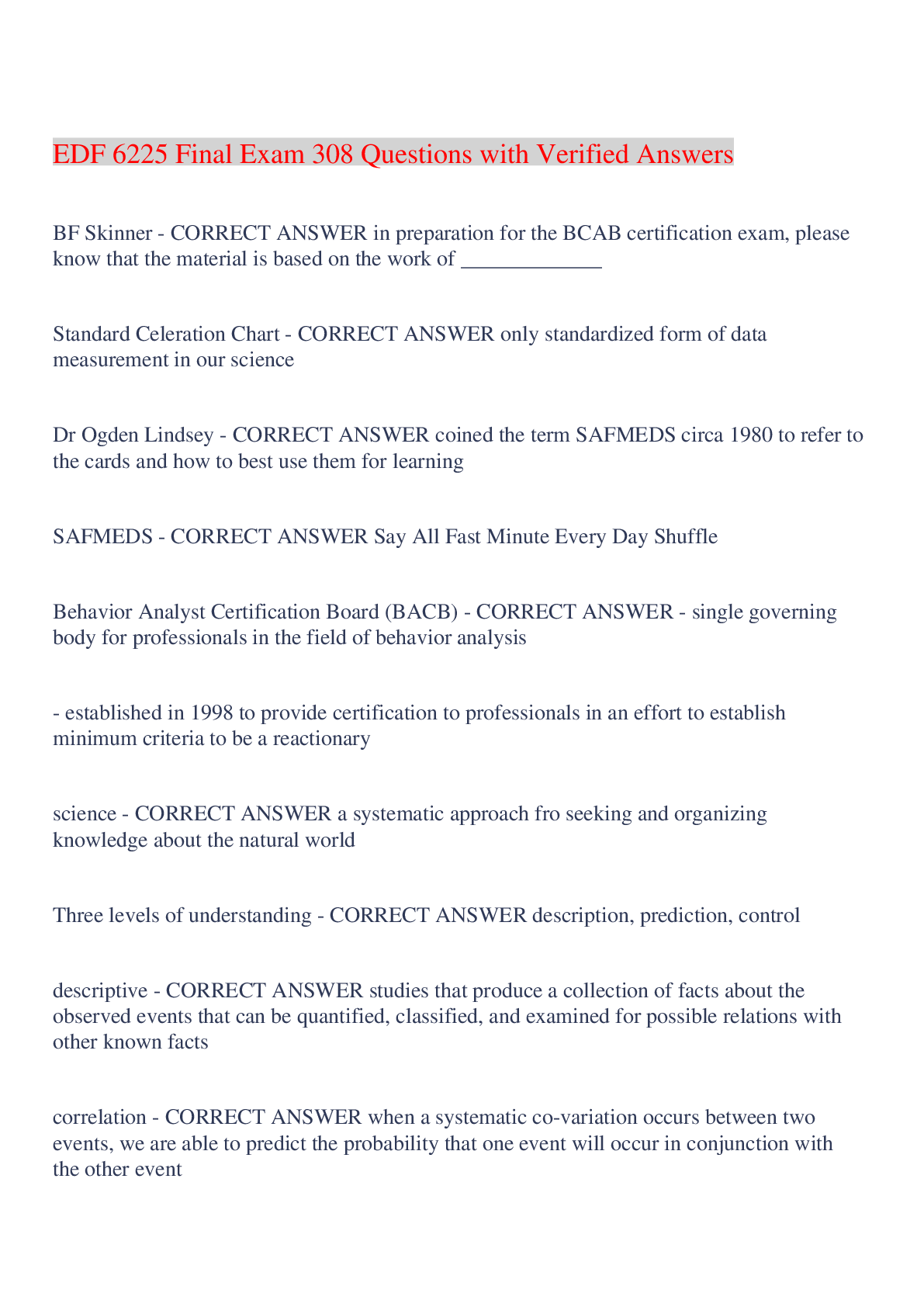
Buy this document to get the full access instantly
Instant Download Access after purchase
Buy NowInstant download
We Accept:

Reviews( 0 )
$10.00
Can't find what you want? Try our AI powered Search
Document information
Connected school, study & course
About the document
Uploaded On
Dec 17, 2023
Number of pages
37
Written in
Additional information
This document has been written for:
Uploaded
Dec 17, 2023
Downloads
0
Views
61


